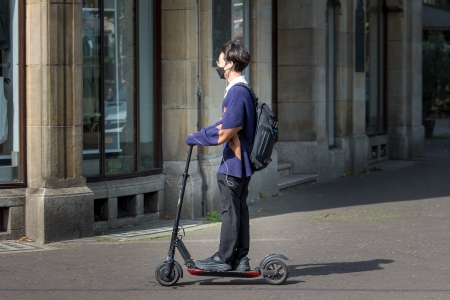Based on available knowledge of, particularly, e-scooters, the OECD International Transport Forum [11] and the European Commission [42] have issued general recommendations for the safe use of and interaction with LEVs. In the Netherlands, several parties, such as ANWB, CROW-Connekt and SWOV, issued reports containing their ideas about safe use of LEVs. And finally, the government is developing a framework for safe admittance of LEVs.
General recommendations
The main recommendations by OECD/ITF and the European Commission (EC) are:
- Develop a shielded and well-maintained LEV infrastructure. Do not allow LEVs on footpaths and pavements and ensure bicycle tracks are wide enough, so that different kinds of vehicles may use them safely. In addition, designated parking spaces for LEVs should be introduced.
- LEV crashes with motorised vehicles are most serious. Make interaction with these vehicles safer, for instance by improving speed enforcement and alcohol checks (also for LEV users), and introducing urban speed limits of 30km/h everywhere.
- Promote helmet use; wearing a helmet reduces the risk of (severe) head injuries.
- Discourage high speeds and hazardous manoeuvres (such as red light running and not giving right of way to pedestrians where required) by pricing e-scooter rental on the basis of distance, not on duration.
- Improve the design and, thus, the safety of LEVs, by the following measures: direction indicators, sound signal, rear view mirrors, reflecting materials, a minimum brake delay of 4 m/s²), and two brakes which function independently.
- Introduce clear LEV regulations: are helmets mandatory, where can LEVs be used, at what speed, after what kind of rider training, at what minimum age, and with what alcohol limit.
OECD/ITF and EC recommend improving awareness of (required) LEV rider behaviour among users of other motor vehicles. Moreover, they think it important to collect LEV data (usage, distance travelled and (near miss) crashes), so that more knowledge may be gained.
Visions for safe LEV use in the Netherlands
ANWB, CROW-Connekt and SWOV have issued reports incorporating their vision on (safe) use of LEVs in traffic. Their main road safety issues are listed below.
ANWB: Vision on regulation of micro vehicles [43]
- Page 14: “adapt national policy or introduce new legislation, creating scope for all light vehicles (including self-balancing vehicles), provided that their product safety is guaranteed. Model legislation on bicycle regulations: same road position, helmets not mandatory, no vehicle insurance, no licence needed, maximum construction speed of 25km/h.”
CROW-Connekt: Microbility: disruption of mobility market with major implications? [44]
- Reducing the speed and the number of cars, particularly in 30km/h zones, will contribute to the road safety of LEVs. Even more so than wearing fluorescent clothes and helmets.
- Organising public space in such a way that walking and cycling are encouraged will contribute to road safety. Bicycle tracks and pavements need to be sufficiently wide and well-maintained.
- The vehicle itself should meet specific requirements. Instructing vulnerable road users about vehicle hazards is not enough.
- The road environment should support expected road user behaviour.
SWOV: Safe innovation: authorisation of LEVs and the future of bicycle tracks [45]
- Pag. 4: “The authorisation of LEVs should contribute to realising social goals, and road safety in any case. The guiding principle is that innovative LEVs can be admitted to road traffic if, on balance, the social benefits of admittance exceed the costs and if, at any rate, road traffic becomes safer.”
- Pag. 4: “Bicycle tracks are primarily intended for cyclist safety. Only those vehicle that are similar to regular bicycles in size, weight, speed and function can safely be used on bicycle tracks.
Recommendations for safe admittance onto Dutch roads
Apart from the general recommendations and visions on the safe use of LEVs mentioned above, the Dutch Safety Board [4], has drafted recommendations for safe admittance and monitoring of all LEV types, which were prompted by the tragic Stint crash in 2018. The main recommendations are:
- Carry out an integral risk assessment of LEVs. This implies an assessment that gives centre stage to the interaction between operator, technology and road environment. Indicate what safety level is acceptable on the basis of government ambitions. Include both new LEVs and those that have already been admitted onto public roads in the assessment. Monitor technology and traffic developments, so that new or altered risks can be identified on time and effective measures can be taken.
- If need be, take additional measures for LEVs that have already been admitted onto public roads if the safety level of these vehicles turns out to be insufficient. This safety assessment includes technological requirements, user and usage requirements and infrastructure.
- Ensure that an independent inspection authority is responsible for assessing whether or not to admit LEVs (nationally authorised vehicles).
The minister of Infrastructure and Water Management has already promised to ‘be mindful of’ and adopt all recommendations in drafting the LEV authorisation framework [46], that is expected to take effect in January 2023.
As part of the integral risk assessment [47] as has been applied in the ‘special moped rule’ since 2020, SWOV have proposed a method to inventory possible risks in the interaction between LEVs, operators and road environment. Consideration will be given to vehicle ergonomics, visibility, possibly improper use, experience and skills of users, vehicle recognisability, possible distraction of other road users caused by the vehicle, the safety of the intended road position, and the collision protection and crashworthiness of the vehicle.
